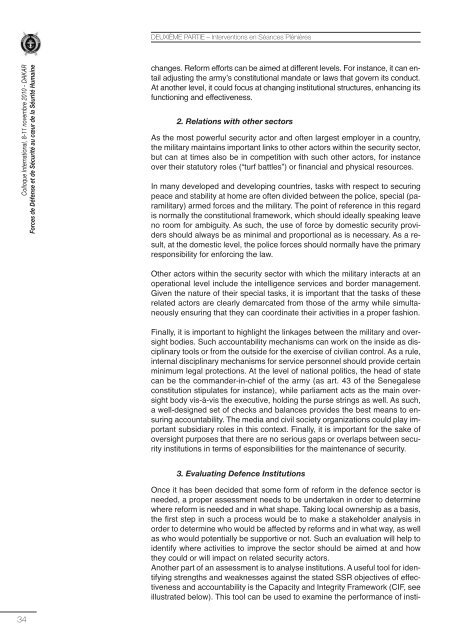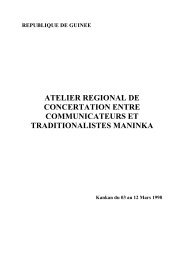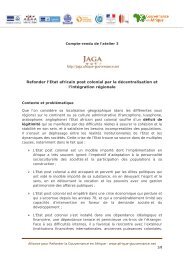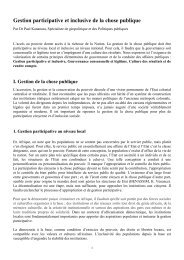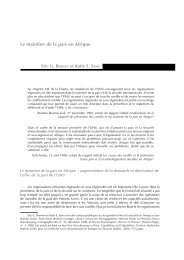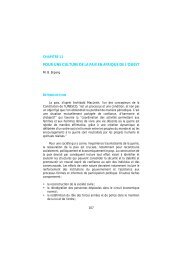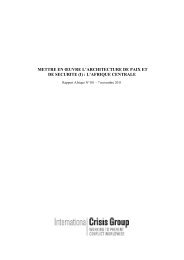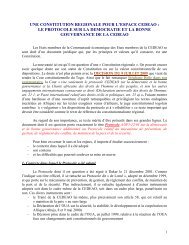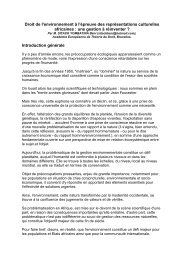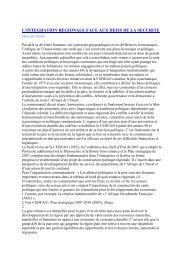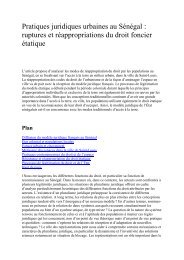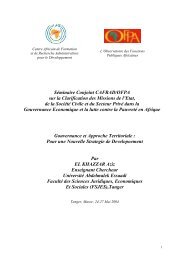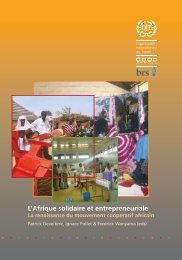Compendium - Fondation Charles Léopold Mayer pour le progrès ...
Compendium - Fondation Charles Léopold Mayer pour le progrès ...
Compendium - Fondation Charles Léopold Mayer pour le progrès ...
Create successful ePaper yourself
Turn your PDF publications into a flip-book with our unique Google optimized e-Paper software.
DEUXIÈME PARTIE – Interventions en Séances PlénièresColloque International, 8-11 novembre 2010 - DAKARForces de Défense et de Sécurité au cœur de la Séurité Humainechanges. Reform efforts can be aimed at different <strong>le</strong>vels. For instance, it can entailadjusting the armyʼs constitutional mandate or laws that govern its conduct.At another <strong>le</strong>vel, it could focus at changing institutional structures, enhancing itsfunctioning and effectiveness.2. Relations with other sectorsAs the most powerful security actor and often largest employer in a country,the military maintains important links to other actors within the security sector,but can at times also be in competition with such other actors, for instanceover their statutory ro<strong>le</strong>s (“turf batt<strong>le</strong>s”) or financial and physical resources.In many developed and developing countries, tasks with respect to securingpeace and stability at home are often divided between the police, special (paramilitary)armed forces and the military. The point of reference in this regardis normally the constitutional framework, which should ideally speaking <strong>le</strong>aveno room for ambiguity. As such, the use of force by domestic security providersshould always be as minimal and proportional as is necessary. As a result,at the domestic <strong>le</strong>vel, the police forces should normally have the primaryresponsibility for enforcing the law.Other actors within the security sector with which the military interacts at anoperational <strong>le</strong>vel include the intelligence services and border management.Given the nature of their special tasks, it is important that the tasks of theserelated actors are c<strong>le</strong>arly demarcated from those of the army whi<strong>le</strong> simultaneouslyensuring that they can coordinate their activities in a proper fashion.Finally, it is important to highlight the linkages between the military and oversightbodies. Such accountability mechanisms can work on the inside as disciplinarytools or from the outside for the exercise of civilian control. As a ru<strong>le</strong>,internal disciplinary mechanisms for service personnel should provide certainminimum <strong>le</strong>gal protections. At the <strong>le</strong>vel of national politics, the head of statecan be the commander-in-chief of the army (as art. 43 of the Senega<strong>le</strong>seconstitution stipulates for instance), whi<strong>le</strong> parliament acts as the main oversightbody vis-à-vis the executive, holding the purse strings as well. As such,a well-designed set of checks and balances provides the best means to ensuringaccountability. The media and civil society organizations could play importantsubsidiary ro<strong>le</strong>s in this context. Finally, it is important for the sake ofoversight purposes that there are no serious gaps or overlaps between securityinstitutions in terms of esponsibilities for the maintenance of security.3. Evaluating Defence InstitutionsOnce it has been decided that some form of reform in the defence sector isneeded, a proper assessment needs to be undertaken in order to determinewhere reform is needed and in what shape. Taking local ownership as a basis,the first step in such a process would be to make a stakeholder analysis inorder to determine who would be affected by reforms and in what way, as wellas who would potentially be supportive or not. Such an evaluation will help toidentify where activities to improve the sector should be aimed at and howthey could or will impact on related security actors.Another part of an assessment is to analyse institutions. A useful tool for identifyingstrengths and weaknesses against the stated SSR objectives of effectivenessand accountability is the Capacity and Integrity Framework (CIF, seeillustrated below). This tool can be used to examine the performance of insti-34


